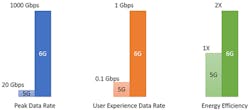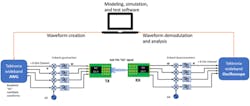Improve the Reliability of 6G Designs with High-Fidelity Test Beds
What you’ll learn:
- How lofty 6G aspirations are challenging test and measurement engineers.
- How to analyze signal quality.
- How to increase design reliability.
The wireless communications industry continues its strong deployment of 5G cellular networks and services to enable greater user data throughput, lower latency, and widespread IoT coverage. While engineers are busy tackling the challenges of commercial 5G implementation, many industry researchers are ramping up their efforts to conceive the next generation of wireless communications: 6G.
At this early stage, the use of easily reconfigurable, high-fidelity, and wide baseband signal-generation and analysis tools give researchers the ability to reliably recreate test scenarios to validate the expected performance indicators.
Lofty Aspirations for 6G KPIs Present T&M Challenges
Industry experts have several ideas of what 6G should accomplish in the next decade when it’s solidly deployed, including data rates in the terabits-per-second range, lower-power communications, and joint communications and sensing. Some of the key performance indicators (KPIs) targeted by industry experts for 6G networks (Fig. 1) are lofty aspirations that pose great engineering challenges and call for a gradual and iterative design process.
Consider, for example, that 6G plans to use channels with 8 GHz or more of instantaneous bandwidth around sub-THz bands from 140 to 300 GHz. At these higher frequencies, the much shorter wavelengths push against semiconductor physics and system-level mechanical dimensions, which can introduce considerable variations in wireless performance.
Furthermore, operating in these large channels requires wider baseband capabilities, faster signal processing, and greater integration of the transceiver and radio chain. A high level of radio-device integration demands exhaustive simulations because it would be very difficult, if not impossible, to directly measure, test, and optimize the individual subsystems and components.
Following the development path of 5G devices in the mmWave range, the engineering of integrated 6G systems will lean on radiated, over-the-air (OTA) measurements. Here, researchers present very wide baseband signals to the device under test (DUT), and then determine the RF performance of their designs by analyzing the demodulated baseband signals at the end of the OTA link.
A hardware-enabled prototyping 6G test bed capable of generating and analyzing wide signals requires test and measurement equipment with very fast and high-fidelity analog-to-digital converters (ADCs) and digital-to-analog converters (DACs). This will minimize measurement uncertainty, provide equalized flatness across wide channels, and simplify the execution of automated test sequences for system characterization (Fig. 2).
Research and development test beds need flexibility to address many frequency bands, various modulation bandwidths, and new types of waveforms. Such test setups also need to scale to many channels to investigate multiple-input, multiple-output (MIMO) techniques.
High-performance arbitrary waveform generators (AWGs) produce high-bandwidth test signals at baseband, taking advantage of very fast sampling rates. These high rates enable low residual error-vector magnitude (EVM) at lower intermediate frequencies thanks to the oversampling processing gain.
Using high-spectral purity local oscillators and D-band (110 to 170 GHz) and G-band (140 to 220 GHz) upconverters to generate sub-terahertz signals with very wide bandwidths, the test bed then translates this wideband signal closer to the sub-THz range. It brings the 6G DUT nearer to its operating frequency and enables the filtering of the undesired image product.
Analyzing 6G Signal Quality
To analyze the signal quality out of the 6G DUT, the system first downconverts from sub-THz frequencies to an intermediate frequency. Then, taking advantage of high-bandwidth, multichannel, real-time oscilloscopes, the system acquires the waveforms and passes the IQ samples to the test computer for demodulation and post-processing.
The test system provides spectral and modulation measurement results, such as occupied bandwidth, modulation constellation, and EVM. Researchers can scale the number of channels for MIMO research thanks to the synchronization and multichannel capabilities of the AWGs and oscilloscopes.
Flexible Test Beds Accelerate Modeling, Simulation, and System Design
At the 2022 International Microwave Symposium, Tektronix let researchers from the technology research institute CEA-Leti (Laboratoire d'électronique des technologies de l'information), Grenoble, France, create a test bed to demonstrate their latest energy-efficient, D-band, wireless receive (RX) and transmit (TX) integrated circuits (ICs) fabricated in 45-nm CMOS RFSOI technology.
Using modeling, simulation, and signal-processing software, the researchers created baseband waveforms using 16-QAM modulation mapped to four channels of 2.16 GHz each. The Tektronix AWG70000 arbitrary waveform generator (AWG) enabled the researchers to generate baseband signals with bandwidths greater than 8 GHz, which were upconverted to an intermediate frequency of 61.5 GHz.
The TX IC performed channel bonding and executed a final upconversion to 147.96 GHz, and then fed the signal to an electromagnetic lens antenna, which in turn generated a narrow beam. Positioned about 20 cm away, the RX IC subsequently picked up the radiated signal, downconverted it to an intermediate signal, and passed it to a low-noise amplifier. This IF signal was fed into a Tektronix DPO70000SX oscilloscope, which digitized the wideband signal and passed the IQ samples to the application software for demodulation.
The researchers achieved a very encouraging data rate of 56.32 Gb/s with a competitive energy consumption (RX+TX) of 18 pJ/bit, including the generation circuitry for the local oscillators (LOs).
On one hand, demonstrating a wireless link over 20 cm doesn’t seem that impressive, but the data rate of more than 56 Gb/s surpasses what many cabled connections can do today. Although it’s a short range, this demonstration highlights the future capabilities of wireless standards to eliminate the need for complicated wiring harnesses and multiple wired data lanes. Engineers could further expand on these capabilities by demonstrating multichannel, parallel links that rely on synchronized wideband AWGs and analyzers.
Researchers can accelerate their modeling, simulation, and system design efforts by trying out their latest ideas on easily reconfigurable, high-fidelity, and wide-bandwidth RF test beds. These flexible test beds take advantage of AWGs, oscilloscopes, and digitizers with very high sampling rates to give researchers reliable tools for design and validation of complex new waveforms, devices, and systems for 6G wireless applications.
As researchers create new prototypes, it becomes even more important to have a toolset that allows for the integration of actual measurements with system-level models. Going a step further, being equipped with analysis tools that operate both on software-modeled and simulated data, as well as actual measured data from high-bandwidth test equipment, will increase the reliability of their designs.
About the Author

Alejandro Buritica
Product Manager, RF & Wireless, Tektronix
Alejandro Buritica has worked in the RF test and measurement industry for nearly 20 years, with experience spanning R&D, test engineering, and marketing management. He currently serves as an RF product manager at Tektronix. Alejandro holds a degree in Electrical Engineering from Universidad Javeriana de Bogotá and a Master’s degree in Wireless Technologies from Politecnico di Torino, Italy.


